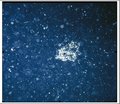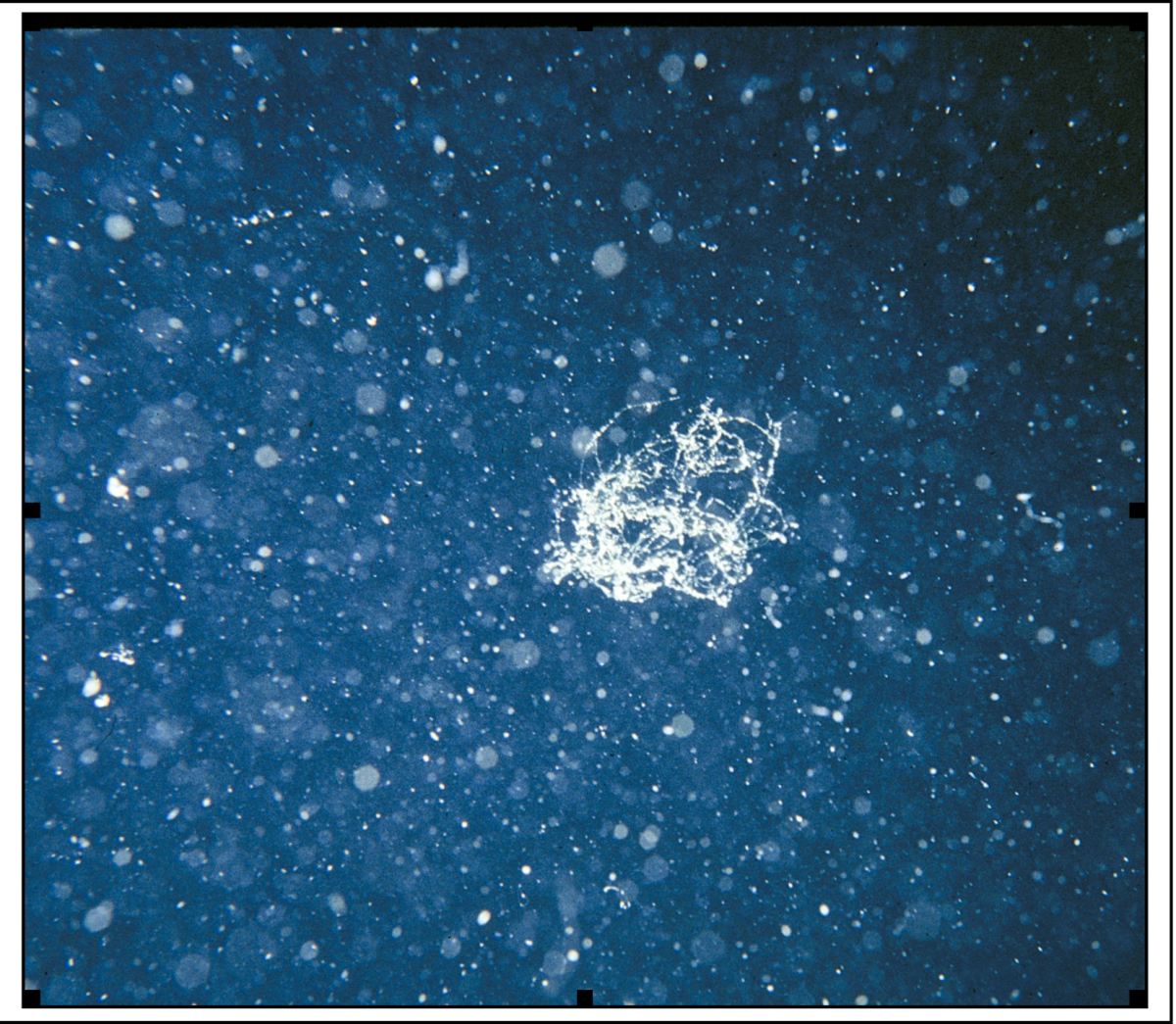Page path:
- Press Office
- Press releases 2010
- 07.12.2010 Carbon Fluxes in the Oceans
07.12.2010 Carbon Fluxes in the Oceans
Carbon Fluxes in the Oceans
Size matters: The strange behavior of small particles at density interfaces
Researchers from the Max Planck Institute for Marine Microbiology in Bremen, Germany and the Massachusetts Institute of Technology (M.I.T.) in Cambridge, Massachusetts have found a remarkable effect while studying how marine particles sink, which could affect the way scientists assess global carbon fluxes. Their question - How fast does organic material and debris clumped together forming porous particles settle to the sea floor? Microbes colonizing these particles degrade the organic matter and release carbon dioxide back to the water. The downward velocity of the particles determines the amount of carbon exported to the deep sea. The results from this study are now presented in the Proceedings of the National Academy of Sciences (DOI: 10.1073/pnas.1012319108).
Structured like sponges, the marine particles are porous aggregates that are mostly void and made of water to 95% or more. Because the world's oceans are stratified due to temperature and/or salinity, water density increases with depth. On their way down to the deep ocean, marine aggregates can reach a depth where they approach neutral buoyancy, stopping in their descent until the exchange of low-density water and heavier ambient water allows settling to resume. Kolja Kindler, a scientist at the Max Planck Institute for Marine Microbiology and the Massachusetts Institute of Technology, points out that although thin layers of marine aggregates have often been observed in nature, this effect has been previously neglected in particle transport models.
Size matters: The strange behavior of small particles at density interfaces
Researchers from the Max Planck Institute for Marine Microbiology in Bremen, Germany and the Massachusetts Institute of Technology (M.I.T.) in Cambridge, Massachusetts have found a remarkable effect while studying how marine particles sink, which could affect the way scientists assess global carbon fluxes. Their question - How fast does organic material and debris clumped together forming porous particles settle to the sea floor? Microbes colonizing these particles degrade the organic matter and release carbon dioxide back to the water. The downward velocity of the particles determines the amount of carbon exported to the deep sea. The results from this study are now presented in the Proceedings of the National Academy of Sciences (DOI: 10.1073/pnas.1012319108).
Structured like sponges, the marine particles are porous aggregates that are mostly void and made of water to 95% or more. Because the world's oceans are stratified due to temperature and/or salinity, water density increases with depth. On their way down to the deep ocean, marine aggregates can reach a depth where they approach neutral buoyancy, stopping in their descent until the exchange of low-density water and heavier ambient water allows settling to resume. Kolja Kindler, a scientist at the Max Planck Institute for Marine Microbiology and the Massachusetts Institute of Technology, points out that although thin layers of marine aggregates have often been observed in nature, this effect has been previously neglected in particle transport models.
Figure: An aquatic aggregate of one centimeter diameter from Lake Constance, Germany (courtesy of Hans-Peter Grossart, IGB, Leibniz-Institute of Freshwater Ecology and Inland Fisheries)
In this study by Kindler and colleagues, the results from laboratory experiments and a mathematical model demonstrate this effect for the first time. As the particles are impermeable to flow, the only means of exchanging water is by diffusion. As a result, the larger the size of the aggregates, the more time they spend in the stratified layer.
Arzhang Khalili from the Max Planck Institute for Marine Microbiology says, "Large marine aggregates may have a longer residence time in the water column than previously expected. This shows that we should revisit current approaches to particle settling to include the effect of porosity, if we want to improve our estimate of the carbon flux in the ocean."
“The deeper we look at microscale phenomena in the ocean, the more we discover that they are the processes that really govern how the Oceans work. Our chances of developing a sustainable approach to how we interact with and use the Oceans hinge on how well we can understand processes at these small scales” adds Roman Stocker from the Massachusetts Institute of Technology.
Manfred Schloesser
Arzhang Khalili from the Max Planck Institute for Marine Microbiology says, "Large marine aggregates may have a longer residence time in the water column than previously expected. This shows that we should revisit current approaches to particle settling to include the effect of porosity, if we want to improve our estimate of the carbon flux in the ocean."
“The deeper we look at microscale phenomena in the ocean, the more we discover that they are the processes that really govern how the Oceans work. Our chances of developing a sustainable approach to how we interact with and use the Oceans hinge on how well we can understand processes at these small scales” adds Roman Stocker from the Massachusetts Institute of Technology.
Manfred Schloesser
Further questions to be addressed to:
Prof. Arzhang Khalili
Max Planck Institute for Marine Microbiology, Celsiusstr. 1, D-28359 Bremen, Germany
E-Mail: [Bitte aktivieren Sie Javascript]
Tel.: +49 (0)421 2028 – 636
Professor of Computational Science
Jacobs University Bremen
School of Engineering & Science
Life Sciences
E-Mail: [Bitte aktivieren Sie Javascript]
Tel.: +49 421 200-3256
Prof. Roman Stocker
Massachusetts Institute of Technology, 77 Massachusetts Avenue, 02139 Cambridge MA, U.S.A.
E-Mail: [Bitte aktivieren Sie Javascript]
Tel.:+1 617 253 3726
and Public relation officers:
Manfred Schlösser
Max Planck Institute for Marine Microbiology, Celsiusstr. 1, D-28359 Bremen
[Bitte aktivieren Sie Javascript]
Tel.: +49 (0)421 2028 - 704
Denise Brehm
MIT Department of Civil and Environmental Engineering
[Bitte aktivieren Sie Javascript]
Tel. +1 617 253 8069
Original title:
“Diffusion-limited retention of porous particles at density interfaces”, by Kolja Kindler, Arzhang Khalili and Roman Stocker (2010).
Contributing Institutes:
•Dept. of Biogeochemistry, Max Planck Institute for Marine Microbiology, Bremen, Germany
•Earth & Space Sciences Program, Jacobs University Bremen, Bremen, Germany
•Department of Civil and Environmental Engineering, Massachusetts Institute of Technology, Cambridge, MA, USA
Prof. Arzhang Khalili
Max Planck Institute for Marine Microbiology, Celsiusstr. 1, D-28359 Bremen, Germany
E-Mail: [Bitte aktivieren Sie Javascript]
Tel.: +49 (0)421 2028 – 636
Professor of Computational Science
Jacobs University Bremen
School of Engineering & Science
Life Sciences
E-Mail: [Bitte aktivieren Sie Javascript]
Tel.: +49 421 200-3256
Prof. Roman Stocker
Massachusetts Institute of Technology, 77 Massachusetts Avenue, 02139 Cambridge MA, U.S.A.
E-Mail: [Bitte aktivieren Sie Javascript]
Tel.:+1 617 253 3726
and Public relation officers:
Manfred Schlösser
Max Planck Institute for Marine Microbiology, Celsiusstr. 1, D-28359 Bremen
[Bitte aktivieren Sie Javascript]
Tel.: +49 (0)421 2028 - 704
Denise Brehm
MIT Department of Civil and Environmental Engineering
[Bitte aktivieren Sie Javascript]
Tel. +1 617 253 8069
Original title:
“Diffusion-limited retention of porous particles at density interfaces”, by Kolja Kindler, Arzhang Khalili and Roman Stocker (2010).
Contributing Institutes:
•Dept. of Biogeochemistry, Max Planck Institute for Marine Microbiology, Bremen, Germany
•Earth & Space Sciences Program, Jacobs University Bremen, Bremen, Germany
•Department of Civil and Environmental Engineering, Massachusetts Institute of Technology, Cambridge, MA, USA

